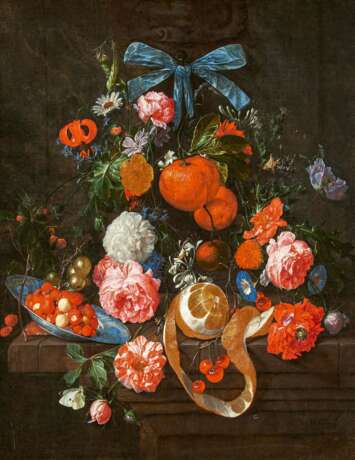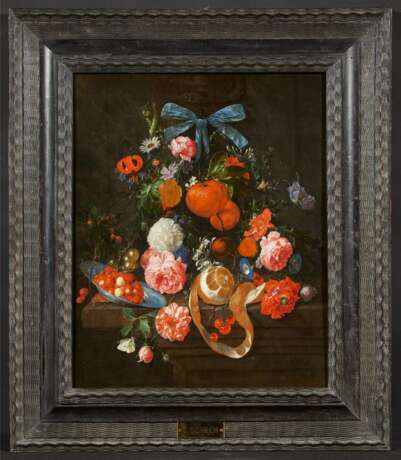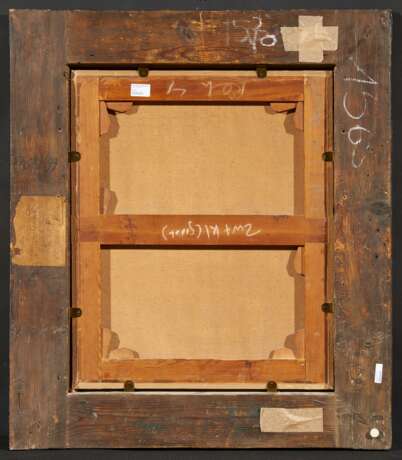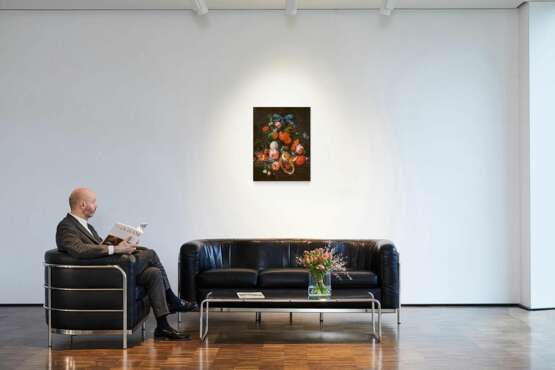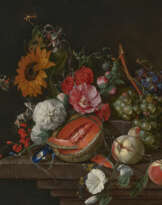Cornelis de Heem. Still Life with Oranges, Roses and Flowers on a Stone Ledge with Berries in a Wanli Bowl, a Peeled Lemon, Cherries and Gooseberries
17.11.2023 15:00UTC +01:00
Classic
Sold
50000EUR € 50 000
| Auctioneer | VAN HAM Kunstauktionen GmbH |
|---|---|
| Event location | Germany, Köln |
| Buyer Premium | 32% |
Archive
The auction is completed. No bids can be placed anymore.

ID 1072388
Lot 1217 | Cornelis de Heem. Still Life with Oranges, Roses and Flowers on a Stone Ledge with Berries in a Wanli Bowl, a Peeled Lemon, Cherries and Gooseberries
Estimate value
€ 60 000 – 80 000
1631 Leiden - 1695 Antwerp
Title: Still Life with Oranges, Roses and Flowers on a Stone Ledge with Berries in a Wanli Bowl, a Peeled Lemon, Cherries and Gooseberries.
Date: around 1665.
Technique: Oil on canvas.
Mounting: Relined.
Measurement: 67 x 55cm.
Notation: Signed lower right: C. De Heem f.
Frame: Framed.
Provenance:
around 1950 Kunsthandel A. Staal, Amsterdam;
Private collection;
Auction Christie's, Amsterdam 13.11.1995;
Private ownership, Germany.
This work is listed in the online database of the RKD, The Hague, figure number 6433.
A feast for (almost) all the senses is this magnificent, brilliantly painted still life by the Antwerp painter Cornelis de Heem. Through the mediation of the eye, the viewer thinks he can smell the fragrance of the blossoms and the half-peeled orange.
Wild strawberries, gooseberries, cherries and oranges as well as the blackberries, which can only be recognised at second glance against the dark wall, show off their taste. The strikingly natural surfaces of the flowers and fruits, as well as the silk bow and the Chinese wan-li plate with blue and white decoration - evidence of the orderly, cultivated human hand - convey a multifaceted tactile experience.
And the eye feasts; it may "stroll" through this arranged chaos and always discover something new. All the assembled flora is identifiable and representatives of the fauna also cavort in the splendour: here a white butterfly that has settled on a rose branch, there a snail that crawls down on this very branch.
At the same time, the arrangement conveys a latent instability and volatility: the exquisite, precious plate stands - intentionally? - at an angle on half a slice of orange; the peeled orange peel, on whose inner, white skin the hanging cherries cast a shadow, threatens to become overweight. In a moment it will plunge with the cut-off fruit cap from the stone parapet on which it lies. Will the orange and a blossom or two then also fall over the near edge? The precious plate placed so wobbly on the corner of the parapet seems in danger.
But the upper part of the arrangement is safe and hangs on the wall as a bouquet with the blue bow on a sturdy iron nail.
The painter of this impressive painting is Cornelis de Heem, the son of the probably most famous still life painter of the "Golden Age" Jan Davidzoon de Heem (1606 - 1684). Cornelis was trained in his father's workshop in Antwerp, and in 1630 he was accepted as a master by the St. Luke's Guild there. Like his father, Cornelis de Heem was active in both the northern and southern Netherlands. Between 1667 and at least 1687 he can be found in Utrecht and The Hague. It is possible that this painting was created during his time in the republican northern provinces, which were under the governorship of the House of Orange. The fruit so centrally placed in the magnificent painting was a symbol of the ruling house in many works of art. The RKD ( Rijksbureau voor Kunsthistorische Documentatie) dates the painting to around 1665, which may correspond to a creation in the northern provinces.
| Artist: | Cornelis de Heem (1631 - 1695) |
|---|---|
| Applied technique: | Oil |
| Auction house category: | Old Masters |
| Artist: | Cornelis de Heem (1631 - 1695) |
|---|---|
| Applied technique: | Oil |
| Auction house category: | Old Masters |
| Address of auction |
VAN HAM Kunstauktionen GmbH Hitzelerstr. 2 50968 Köln Germany | ||||||||||||||
|---|---|---|---|---|---|---|---|---|---|---|---|---|---|---|---|
| Preview |
| ||||||||||||||
| Phone | +49 221 92586215 | ||||||||||||||
| Fax | +49 221 92 58 62 4 | ||||||||||||||
| Buyer Premium | 32% | ||||||||||||||
| Conditions of purchase | Conditions of purchase | ||||||||||||||
| Business hours | Business hours
|
